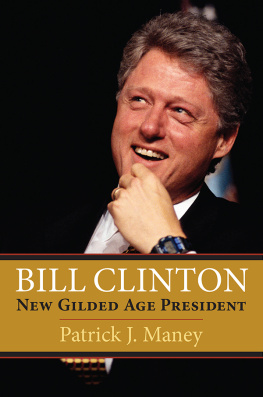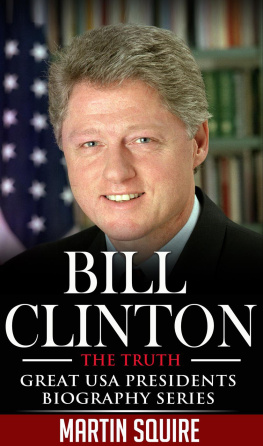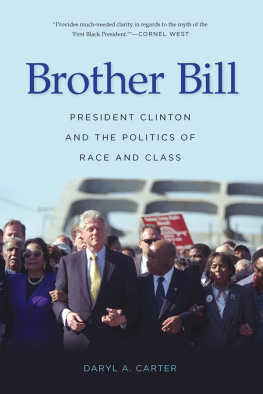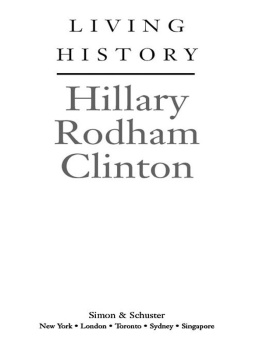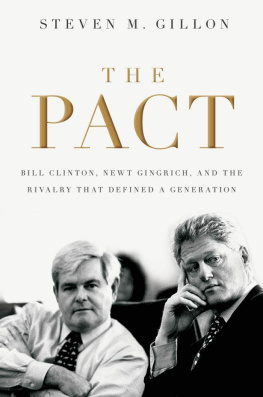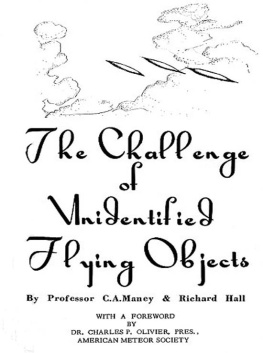Bill Clinton
Bill Clinton
New Gilded Age President
Patrick J. Maney
U N I V E R S I T Y P R E S S O F K A N S A S
2016 by the University Press of Kansas
All rights reserved
Published by the University Press of Kansas (Lawrence, Kansas 66045 ), which was organized by the Kansas Board of Regents and is operated and funded by Emporia State University, Fort Hays State University, Kansas State University, Pittsburg State University, the University of Kansas, and Wichita State University
Library of Congress Cataloging-in-Publication Data
Maney, Patrick J., 1 author.
Bill Clinton : New Gilded Age president / Patrick J. Maney.
pages cm
Includes bibliographical references and index.
ISBN 978-0-7006-2194-1 (cloth : alk. paper) ISBN 978-0-7006-2199-6 (ebook)
Clinton, Bill, 1946 2. PresidentsUnited StatesBiography. United StatesPolitics and government 19932001. I. Title.
E . M 2016
973.929092 dc
[B]
2015035636
British Library Cataloguing-in-Publication Data is available.
Printed in the United States of America
The paper used in this publication is recycled and contains percent postconsumer waste. It is acid free and meets the minimum requirements of the American National Standard for Permanence of Paper for Printed Library Materials Z.- 1992 .
In memory of Bob and Gay Zieger
CONTENTS
acknowledgments
This study would not have been possible without the help and encouragement of many. My greatest debt is to Lawrence Powell of Tulane Universityfriend, colleague, and sounding board for thirty-five years. He reads just about everything I write and always makes it better. Everybody should be so lucky.
I am grateful to Fred Woodward for inviting me to write about Clinton. He has an inexhaustible store of patience as well as an unerring knack for knowing when to prod and when to reassure. In a transformative era in publishing, his leadership at the press has been nothing short of remarkable. Insofar as the press is concerned at least, nothings the matter with Kansas. Thanks are also due to the presss managing editor, Kelly Chrisman Jacques, and to copyeditor Martha Whitt. Herbert Reagan at the Clinton Library in Little Rock was enormously helpful in the selection of photographs.
Kent Germany of the University of South Carolina read an early draft of the manuscript and improved it immeasurably, as did Burton I. Kaufman, whose meticulous scholarship I have long admired. My Boston College colleague Seth Jacobs read the chapters on foreign policy and saved me from numerous errors of fact and judgment. I cant thank them enough for their help.
Longtime friends and former colleagues Clarence Mohr, Robert Hunter, Dan Carter, Patricia Sullivan, and Bill and Bobbie Malone have been steady providers of useful ideas and timely encouragement. In addition, Clarence Mohr gave me an opportunity to try out some of my ideas by inviting me to speak at the University of South Alabama, where he is history department chair extraordinaire.
Here at Boston College a smart and dedicated group of undergraduates provided invaluable research assistance: David Quinn, Gregory Manne, Brady Conley, Matthew Wagner, Alexandra Laham, and Giancarlo Ambrogio. They proved particularly adept at tracking down and analyzing sources that had eluded me.
I am grateful to economists Laura DAndrea Tyson, Alicia Munnell, and Robert Murphy for helping me to understand Clintonomics as well as many other aspects of the administration in which they served. Sidney Blumenthal, whose Clinton Wars remains a major work to be reckoned with, generously offered encouragement and advice. A conversation with the late John Hope Franklin, who spearheaded President Clintons Initiative on Race, deepened my understanding of an underappreciated and misunderstood episode of the Clinton presidency.
Two years ago, Robert and Gay Zieger died just months apart from one another. Bob was my academic adviser and first history teacher in college. I became a historian because of him. For my wife, Elaine (also a Bob student), and me, the Ziegers were dear friends, mentors, and role models for over forty years. Hardly a day goes by that we dont think about them. It is to their memory that we dedicate this book.
I owe my deepest appreciation to family. Sons Kevin, John, and Thomas, and Kevins wife, Alli, are constant sources of joy and inspiration. As with everything Ive ever done, Elaine has brought a sharp eye and keen intelligence to bear on this project. She is the anchor of our familyan inexhaustible source of love, optimism, and common sense.
Bill Clinton
introduction: bill clinton and the new gilded age
Bill Clintons quest for the presidency coincided with Americas rediscovery of the Gilded Age, that late-nineteenth-century era unforgettably christened by Mark Twain and Charles Dudley Warner. It was a nation glittery on the outside but cheap and tawdry beneath the surface.
But just as Clinton was embarking on his presidential campaign in the early nineties, interest in those gilded decades took a more serious turn. Commentators began noting disturbing similarities with their own times: unsettling change, growing income inequality, conspicuous consumption, racial and ethnic tensions, government largesse for the rich and well born. And in politics: scandalsreal and trumped upand partisan warfare out of proportion to the actual differences between the parties. If the roaring nineties had Millionaires Row with its ornate mansions, the 1990 s had McMansions inside gated communities. It was enough to constitute a new Gilded Age. Too many stretch limousines in Manhattan, too many yacht jams off Newport Beach and too many fur coats in Aspen, onetime conservative activist Kevin Phillips complained in 1990 , noting that during the 1980 s alone the number of millionaires had tripled, while median family income had budged hardly at all.
In both ages, economic forces were in the drivers seat, presidents and politicians along for the ride. There is no other period in the nations history, historian Richard Hofstadter wrote of the original Gilded Age, when politics seems so completely dwarfed by economic changes, none in which the life of the country rests so completely in the hands of the industrial entrepreneur. The industrialists of the Gilded Age [here hes thinking of the Carnegies, Rockefellers, and J. P. Morgans] were... men of heroic audacity and magnificent exploitative talentsshrewd, energetic, aggressive, rapacious, domineering, insatiable.... From them the era took its tone and color.
The parallels between the two eras were not lost on Bill Clinton. He returned to the first Gilded Age time after time, as well as to the Progressive Era that followed. He believed those times were most like his own, with useful lessons for the present.
To Clinton, the defining characteristic of both ages was changechange so vast and far-reaching, it happened only a few times in American history. But when it did happen, the way people lived and worked was changed forever. Clinton employed the argot of social science to capture the change he had in mind: it was, he said, nothing less than a paradigm shift. The Gilded Age was when agrarian America morphed into an urban industrial behemoth. A century later Clinton observed: Were going from the industrial age to an information-technology age, from the Cold War to a global society. The results were uncannily similar. He spotlighted the enormous changes in the way people work and live. There has been, he said, a large increase in immigration and an increasing diversity in America, with all the tensions that that brings. There are vast fortunes being madepeople are having opportunities they never dreamed of. But a lot of people have been dislocated. Clinton had a more nuanced view of the Gilded Age than many. There was more to it than robber barons and huddled masses. It was an age of grand inventions like the electric light, telephone, phonograph, automobile, and motion picture; of medical and scientific breakthroughs; of new and interesting ways of understanding human behavior. Clinton also acknowledged important differences between the two ages. The middle class of his time was both larger and protected by a social safety net that had been practically nonexistent a century earlier. On the other hand, Americans were less inclined to look to Washington for a solution to their problems than their counterparts in the late nineteenth and early twentieth centuries.


